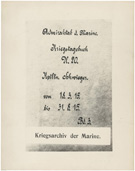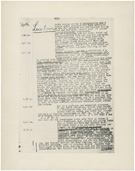War at Sea
Kapitšnleutnant Walter Schwieger - Sinking of the RMS Lusitania, 1915
“Travellers intending to embark on the Atlantic voyage are reminded that a state of war exists between Germany . . . and Great Britain . . . and that travellers sailing in the war zone on ships of Great Britain or her allies do so at their own risk.”
So read a notice from the German government that ran in forty U.S. newspapers on May 1, 1915, ten months after the outbreak of World War I and three months after Germany declared a submarine blockade of the British Isles. On that day, the British luxury liner, the RMS Lusitania, set sail from New York for Liverpool; six days later, twelve miles off the southern coast of Ireland, she was torpedoed by a German submarine and sank. Of the 1,959 people on board, 1,195 died, including more than 120 Americans.
In the context of a wartime crossing, the cargo of the Lusitania on her last voyage included war materiel for the Allied war effort, including 52 tons of shrapnel shells, more than 3,000 percussion fuses, and 4,200 cases of Remington rifle cartridges. Kapitänleutnant Walter Schwieger was the thirty-year-old commander of the submarine U-20 that sank the Lusitania. His war diary describes the attack and the rapid sinking of the great liner as he viewed it through his periscope.
War diary of Kapitšnleutnant Walter Schwieger recording the attack and sinking of the Lusitania, May 7, 1915, title page
This copy of Schwieger’s diary came to the Department of the Navy (and, eventually, to the National Archives) through the U.S. Army’s Military Intelligence Division.
In the diary, typed from his handwritten notes, Schwieger stated that he caught sight of the Lusitania in the distance, while his submarine was surfaced; he quickly submerged his vessel, moved into an attack position, and at 3:10 p.m., ordered the launch of the torpedo from a distance of 700 meters.
The diary chronicles the chaos and panic he observed while the ship’s crew and passengers tried to put the lifeboats in the water as the ship listed sharply starboard. The ship sank after eighteen minutes; only six of the forty-eight lifeboats had made it safely into the water.
The cause of the explosion on board the Lusitania has been the subject of study and debate since 1915. Experts tend to agree now that the explosion was caused by an industrial accident (likely the detonation of coal dust or aluminum powder ignited by fire resulting from the torpedo hit), rather than the combustion of explosive munitions on board.
National Archives, Naval Records Collection of the Office of Naval Records and Library
Excerpt:
“Clear bow shot at 700 [meters] . . . Shot struck starboard side close behind the bridge. An extraordinarily heavy detonation followed, with a very large cloud of smoke (far above the front funnel). A second explosion must have followed that of the torpedo (boiler or coal or powder?). . . . The ship stopped immediately and quickly listed sharply to starboard, sinking deeper by the head at the same time. It appeared as if it would capsize in a short time. Great confusion arose on the ship; some of the boats were swung clear and lowered into the water.”
—From an official translation of Schwieger’s diary
.
War diary of Kapitšnleutnant Walter Schwieger recording the attack and sinking of the Lusitania, May 7, 1915, page 8
This copy of Schwieger’s diary came to the Department of the Navy (and, eventually, to the National Archives) through the U.S. Army’s Military Intelligence Division.
In the diary, typed from his handwritten notes, Schwieger stated that he caught sight of the Lusitania in the distance, while his submarine was surfaced; he quickly submerged his vessel, moved into an attack position, and at 3:10 p.m., ordered the launch of the torpedo from a distance of 700 meters.
The diary chronicles the chaos and panic he observed while the ship’s crew and passengers tried to put the lifeboats in the water as the ship listed sharply starboard. The ship sank after eighteen minutes; only six of the forty-eight lifeboats had made it safely into the water.
The cause of the explosion on board the Lusitania has been the subject of study and debate since 1915. Experts tend to agree now that the explosion was caused by an industrial accident (likely the detonation of coal dust or aluminum powder ignited by fire resulting from the torpedo hit), rather than the combustion of explosive munitions on board.
National Archives, Naval Records Collection of the Office of Naval Records and Library
Excerpt:
“Many people must have lost their heads; several boats loaded with people rushed downward, struck the water bow or stern first and filled at once. . . . The ship blew off steam; at the bow the name “Lusitania” in golden letters was visible. The funnels were painted black; stern flag not in place. It was running 20 nautical miles. Since it seemed as if the steamer could only remain above water for a short time, went to 24 m. and ran toward the Sea. Nor could I have fired a second torpedo into this swarm of people who were trying to save themselves.”
—From an official translation of Schwieger’s diary
.
Torpedoed Lusitania, drawing printed in New York Herald and London Sphere, ca. 1915
Courtesy of the Library of Congress, Prints and Photographs Division, Washington, DC
.
Kapitšnleutnant Walter Schwieger, not dated
Schwieger was an aggressive and skillful naval officer. In 1917, he received the highest honor that a German naval officer could receive. He died at sea that September when his U-boat struck a mine.
Courtesy of Bundesarchiv, Freiburg, Germany
.



